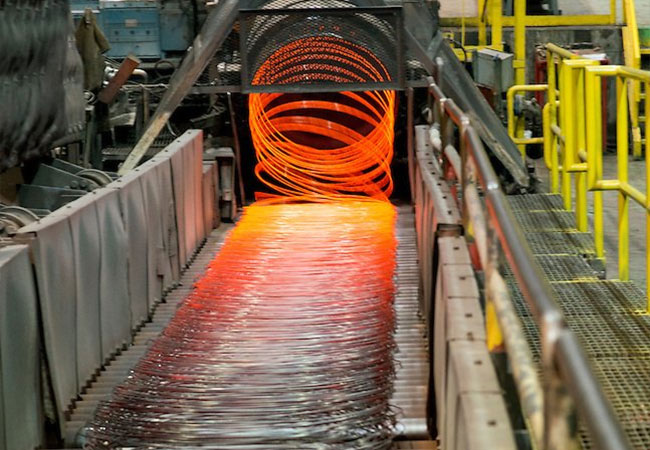Keywords: high-speed wire rod process
Description: Due to the high rolling speed and small cross-sectional dimensions of smaller-sized wire rod products, steel piling incidents frequently occur. This article categorizes and analyzes causes and countermeasures according to different rolling zones.
Causes and Solutions for Steel Piling in High-Speed Wire Rod Rolling
The production line at China SHOUGANG No. 1 Wire Rod Factory achieves a maximum stable rolling speed of 88 m/s. It comprises 28 rolling stands: 14 roughing and intermediate mills, 4 pre-finishing mills arranged in alternating horizontal and vertical configurations, and 10 finishing mills set at a 45° top-bottom orientation, along with feed rolls and a laying head. Products range from φ5.5 mm to φ16 mm, covering a wide span of specifications and varieties. Currently, for sizes φ6.5 mm and below, the high rolling speed and small cross-section lead to a significantly higher incidence of steel piling compared to other sizes. This article analyzes the causes and proposes solutions by rolling zone.
1. Roughing and Intermediate Rolling Zone (Stands 1–14)
1.1 Piling Due to Failure to Enter Next Stand
Main Causes:
① Skewed leading end exiting previous stand;
② Cobble at previous stand’s exit dislodging the guide;
③ Incorrect entry guide opening adjustment;
④ Misalignment between guide and roll pass (incorrect rolling line);
⑤ Slipping in the groove;
⑥ Out-of-spec workpiece dimensions;
⑦ Leading end split caused by billet defect.
Solutions:
① Check roll diameters and wear, transmission joint gaps, and height consistency of entry/exit guides for workpiece lifting;
② Adjust entry guide opening and guide-to-roll distance appropriately;
③ For new grooves, if roll gap is too small, readjust roll gap or regroove;
④ Properly adjust mill roll gap;
⑤ Inspect billets carefully and increase cropping length at #1 shear.
1.2 Interstand Piling After Workpiece Biting
Main Causes:
① Human error in setting rolling speed or roll diameter;
② Improper loop adjustment after roll or groove change;
③ Excessive billet temperature fluctuation;
④ Sudden speed change due to electrical control issue;
⑤ Incorrect speed adjustment by main console operator.
Solutions:
① Correctly set rolling speed and roll diameter; adjust interstand looping relationship with confirmation between operators;
② Notify furnace operators to adjust heating; maintain temperature during delays;
③ Inspect electrical systems and clear backup cabinet.
1.3 Tail-End Piling
Main Cause: Upstream stand drawing the tail out, causing piling downstream.
Solution: Adjust looping relationship and mill setting.
2. Pre-Finishing Zone (Stands 15–18)
2.1 Interstand Piling
Main Causes:
① Incorrect roll gap, diameter, or speed settings;
② Improper guide installation;
③ Guard impact;
④ Cobble or drawing in roughing/intermediate zone affecting tail end;
⑤ Abnormal mill speed due to electrical issue.
Solutions:
① Recheck parameter settings;
② Inspect, adjust, or replace entry/exit guides;
③ Adjust pre-finishing loop height and enhance inspection;
④ Readjust continuous mill looping relationship;
⑤ Inspect electrical system and clear backup cabinet.
2.2 Pre-Finishing Mill Shift Issues
Main Causes:
① Cooling water pressure or lubrication failure;
② Motor trip;
③ Activation of accident detection system.
Solutions:
① Check water pressure and local control valve;
② Inspect lubrication system;
③ Check pre-finishing loop hanger fastening and proximity switch.
3. High-Speed Zone (Finishing Mill to Laying Head)
3.1 Interstand Piling in Finishing Mill
Main Causes:
① Guide wheel not turning or bearing seizure;
② Workpiece threading issue;
③ Incorrect guide/guard or roll ring installation;
④ Improper roll gap or incoming size;
⑤ Broken roll ring;
⑥ Broken loop wire triggering auto-stop.
Solutions:
① Replace guide and guard; reinforce correct installation;
② Enhance billet inspection and increase crop length;
③ Recheck and adjust roll gap;
④ Replace roll ring and inspect cooling water pipes;
⑤ Check loop hanger proximity switch and for scrap steel in guides; reset finishing mill gap if needed.
3.2 Piling at Finishing Mill Scrap Box
Occurs with or without looping.
Main Causes:
① Water cooling section valve failing to close or opening too early;
② Foreign material in water cooling section;
③ Misaligned water cooling channel;
④ Excessive water flow/pressure in first cooling box after finishing mill;
⑤ Speed mismatch among finishing mill, pinch roll, and laying head.
Solutions:
① Inspect water valve control system; test manually; adjust opening delay;
② Check nozzle/guide alignment, tightness, and for blockages; clear with φ13 mm bar;
③ Adjust speed synchronization;
④ Increase nozzle/guide size (e.g., φ12 mm to φ16 mm).
3.3 Piling at Pinch Roll/Laying Head
Main Causes:
① Worn/misaligned pinch roll inlet/outlet conduit or foreign material;
② Faulty detection signal delaying pinch roll operation;
③ Severely worn laying pipe;
④ Tail pinch delay too short;
⑤ Speed mismatch;
⑥ Internal (smelting) or rolling defects (folds/ears) causing piling.
Solutions:
① Check/replace conduits;
② Inspect detection signal;
③ Replace laying pipe;
④ Increase tail pinch delay;
⑤ Adjust speed matching;
⑥ Address material/process defects.
4. Piling at Flying Shear
Main Causes:
① Speed mismatch with upstream mill, causing bent ends;
② Short tail failing to be fully cut;
③ Worn blade or switch causing incorrect cut;
④ Mid-shear malfunction.
Solutions:
① Reset shear lead factor;
② Adjust head/tail crop length;
③ Inspect shear blade and front guide;
④ Check photocell and thermal detection signal.
5. Piling at Looper
Main Causes:
① Incorrect looper delay;
② Improper looper height;
③ Worn looper roller, guide, or plate;
④ Looper scanner failure;
⑤ Obstructed thermal detection signal;
⑥ Water mist or sunlight affecting inspection.
Solutions:
① Reset parameters;
② Replace worn parts;
③ Replace/adjust looper scanner;
④ Install blower for mist or shield for sunlight.
In production, quick and accurate diagnosis is essential when piling occurs. Comprehensive analysis of multiple factors helps shorten downtime and prevent recurrence. Regular inspection of workpiece dimensions, mill looping relations, and guide/guard conditions by operators is crucial to minimizing such incidents.


